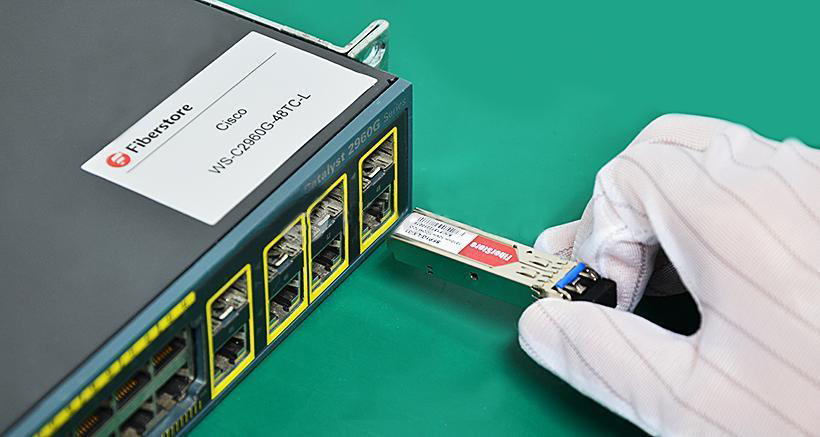Basic Introduction
As is known to all, Cisco GLC-LH-SMD
is the replacement of GLC-LH-SM. It consists five parts: the LD driver,
the limiting amplifier, the digital diagnostic monitor, the 1310nm FP
laser and the PIN photo-detector. Supporting a data rate of 1.25 Gbps,
this GLC-LH-SMD SFP transceiver operates on standard single-mode fiber
optic link spans of up to 10 km and up to 550 m on any multimode fibers.
You may say the letter “D” is the only difference between the two, and
ask what’s the meaning of “D” and why GLC-LH-SMD can take the place of
GLC-LH-SM? This article will give you an answer by introducing its
additional function—DDM (digital diagnostic monitoring).
What Is DDM?
Actually,
the letter “D” stands for the digital diagnostic monitoring function
according to the industry standard multi-source agreement (MSA) SFF-8472
and is known as digital optical monitoring (DOM). A fiber optic
transceiver with DDM is higher end than the one without DDM function.
The DDM function gives end users the ability to monitor real-time
parameters of the optical transceivers, such as the transceiver
temperature, laser bias current, transmitted optical power, received
optical power and transceiver supply voltage. Most of today’s fiber
optic transceivers have this function.
Functions of DDM
After
knowing what digital diagnostic monitoring is, next we’d move to the
functions of DDM or what DDM can actually do. Literally, DDM is able to
provide component monitoring on transceiver applications in details like
the real-time parameters listed in the previous paragraph. But that’s
not all functions of DDM. The SFF-8472 added DDM interface and outlined
that DDM interface is an extension of the serial ID interface defined in
GBIC specification and the SFP MSA. This DDM interface defines a
sophisticated system of alarm and warning flags, which alerts end users
when particular operating parameters are inconsistent with the
factory-set normal range. So the DDM interface is also able to let the
end users have the ability to achieve fault isolation and failure
prediction. The three functions (component monitoring, fault isolation,
failure prediction) will be stated in more details below.
Component Monitoring
Component
monitoring is the most familiar function to users. Usually the key
parameters of the optical transceivers—transceiver temperature,
transceiver supply voltage, laser bias current, transmit average optical
power and received optical modulation amplitude (OMA) or average
optical power, will be monitored. If the transceiver’s specified
operating limits are exceeded and compliance cannot be ensured, these
real-time diagnostic parameters will alert the system.
Fault Isolation
Fault
isolation is the second function of DDM. The DDM is able to isolate the
particular location of fault in an optical network system. With the
combination of the DDM interface status flags, transceiver hard pins and
diagnostic parametric monitor data, it’s easy to pinpoint the specific
location and cause of a link failure.
Failure Prediction
Failure
prediction is the last function of DDM. Based on the transceiver
parametric performance, the DDM can be helpful in failure prediction on
fiber optic links. Device faults and high error rate conditions are the
two basic types of failure conditions which can be seen on optical
transceivers. Device fault means non-operation or malfunction. With the
nature of semiconductor lasers, this is usually applied to transmitter
performance. High error rate conditions refer to the operating
conditions that transceiver is operating at its signal-to-noise limit.
This is typically applied to optical fiber performance.

Summary
After
reading the above statement, have you got a better understanding about
the DDM function of GLC-LH-SMD? Fiberstore’s GLC-LH-SMD small form
factor pluggable (SFP) transceiver is compatible with the small form
factor pluggable multi-source agreement (MSA). This transceiver is
programmed to be fully compatible and functional on a wide range of
Cisco equipment. All Cisco compatible GLC-LH-SMD 1000BASE-LX/LH SFP
transceivers from Fiberstore are all tested on Cisco original equipment
to ensure their superior quality and performance (see the picture
above). Besides the GLC-LH-SMD SFP transceiver, many other Cisco
compatible transceivers provided by Fiberstore, such as SFP-10G-LR
and QSFP-40G-CSR4, have to be tested before arriving to customers. For
more detailed information about us, please visit www.fs.com or contact
over sales@fs.com.
没有评论:
发表评论